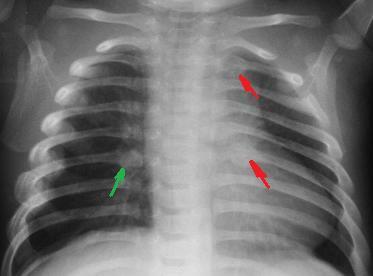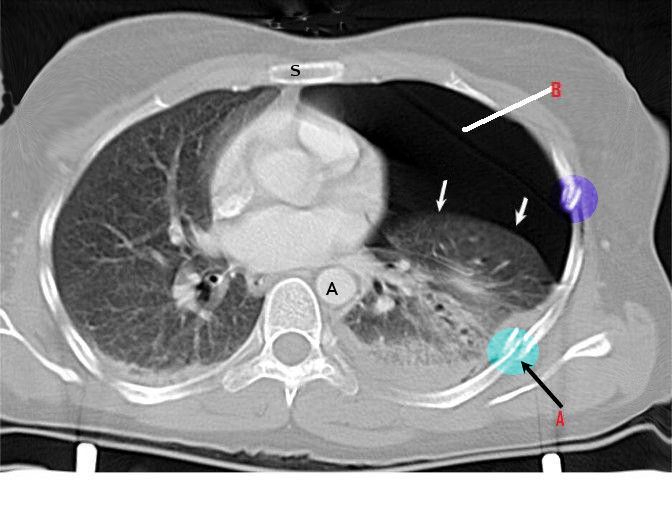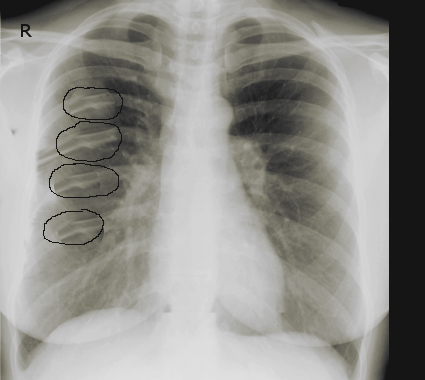[1]
Graeber GM, Nazim M. The anatomy of the ribs and the sternum and their relationship to chest wall structure and function. Thoracic surgery clinics. 2007 Nov:17(4):473-89, vi. doi: 10.1016/j.thorsurg.2006.12.010. Epub
[PubMed PMID: 18271162]
[2]
Bulger EM, Arneson MA, Mock CN, Jurkovich GJ. Rib fractures in the elderly. The Journal of trauma. 2000 Jun:48(6):1040-6; discussion 1046-7
[PubMed PMID: 10866248]
[3]
Katrancioglu O, Akkas Y, Arslan S, Sahin E. Spontaneous rib fractures. Asian cardiovascular & thoracic annals. 2015 Jul:23(6):701-3. doi: 10.1177/0218492315586485. Epub 2015 May 8
[PubMed PMID: 25957093]
[4]
Garcia VF, Gotschall CS, Eichelberger MR, Bowman LM. Rib fractures in children: a marker of severe trauma. The Journal of trauma. 1990 Jun:30(6):695-700
[PubMed PMID: 2352299]
[5]
Kemp AM, Dunstan F, Harrison S, Morris S, Mann M, Rolfe K, Datta S, Thomas DP, Sibert JR, Maguire S. Patterns of skeletal fractures in child abuse: systematic review. BMJ (Clinical research ed.). 2008 Oct 2:337():a1518. doi: 10.1136/bmj.a1518. Epub 2008 Oct 2
[PubMed PMID: 18832412]
Level 1 (high-level) evidence
[6]
Boele van Hensbroek P, Mulder S, Luitse JS, van Ooijen MR, Goslings JC. Staircase falls: high-risk groups and injury characteristics in 464 patients. Injury. 2009 Aug:40(8):884-9. doi: 10.1016/j.injury.2009.01.105. Epub 2009 May 31
[PubMed PMID: 19486973]
Level 3 (low-level) evidence
[7]
Iwamoto J, Takeda T. Stress fractures in athletes: review of 196 cases. Journal of orthopaedic science : official journal of the Japanese Orthopaedic Association. 2003:8(3):273-8
[PubMed PMID: 12768465]
Level 3 (low-level) evidence
[8]
Pettiford BL, Luketich JD, Landreneau RJ. The management of flail chest. Thoracic surgery clinics. 2007 Feb:17(1):25-33
[PubMed PMID: 17650694]
[9]
Assi AA, Nazal Y. Rib fracture: Different radiographic projections. Polish journal of radiology. 2012 Oct:77(4):13-6
[PubMed PMID: 23269931]
[10]
Turk F, Kurt AB, Saglam S. Evaluation by ultrasound of traumatic rib fractures missed by radiography. Emergency radiology. 2010 Nov:17(6):473-7. doi: 10.1007/s10140-010-0892-9. Epub 2010 Jul 23
[PubMed PMID: 20652719]
[11]
Hwang EG, Lee Y. Effectiveness of intercostal nerve block for management of pain in rib fracture patients. Journal of exercise rehabilitation. 2014 Aug:10(4):241-4. doi: 10.12965/jer.140137. Epub 2014 Aug 31
[PubMed PMID: 25210700]
[12]
Doben AR, Eriksson EA, Denlinger CE, Leon SM, Couillard DJ, Fakhry SM, Minshall CT. Surgical rib fixation for flail chest deformity improves liberation from mechanical ventilation. Journal of critical care. 2014 Feb:29(1):139-43. doi: 10.1016/j.jcrc.2013.08.003. Epub 2013 Sep 24
[PubMed PMID: 24075300]
[13]
Pieracci FM, Coleman J, Ali-Osman F, Mangram A, Majercik S, White TW, Jeremitsky E, Doben AR. A multicenter evaluation of the optimal timing of surgical stabilization of rib fractures. The journal of trauma and acute care surgery. 2018 Jan:84(1):1-10. doi: 10.1097/TA.0000000000001729. Epub
[PubMed PMID: 29077677]
[14]
Rostas JW, Lively TB, Brevard SB, Simmons JD, Frotan MA, Gonzalez RP. Rib fractures and their association With solid organ injury: higher rib fractures have greater significance for solid organ injury screening. American journal of surgery. 2017 Apr:213(4):791-797. doi: 10.1016/j.amjsurg.2016.08.002. Epub 2016 Aug 28
[PubMed PMID: 27663650]
[15]
Close J, Ellis M, Hooper R, Glucksman E, Jackson S, Swift C. Prevention of falls in the elderly trial (PROFET): a randomised controlled trial. Lancet (London, England). 1999 Jan 9:353(9147):93-7
[PubMed PMID: 10023893]
Level 1 (high-level) evidence



